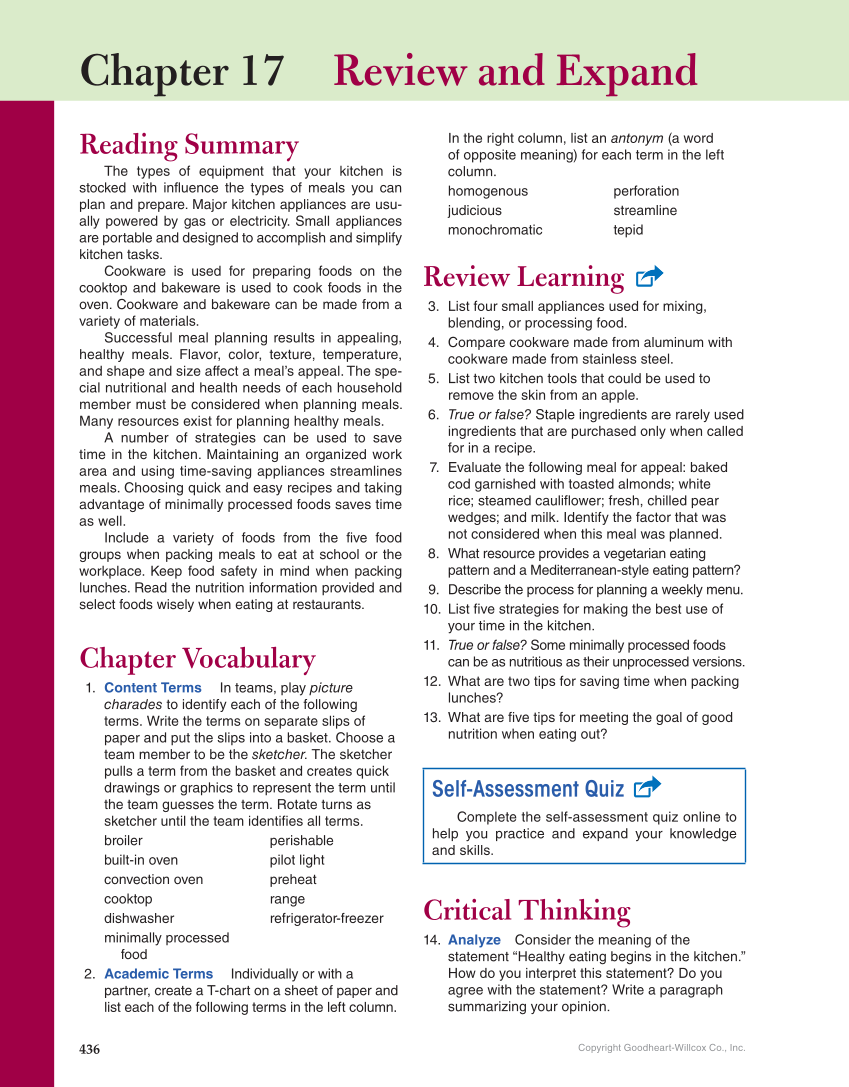Copyright Goodheart-Willcox Co., Inc. Chapter 17 Review and Expand 436 Reading Summary The types of equipment that your kitchen is stocked with influence the types of meals you can plan and prepare. Major kitchen appliances are usu- ally powered by gas or electricity. Small appliances are portable and designed to accomplish and simplify kitchen tasks. Cookware is used for preparing foods on the cooktop and bakeware is used to cook foods in the oven. Cookware and bakeware can be made from a variety of materials. Successful meal planning results in appealing, healthy meals. Flavor, color, texture, temperature, and shape and size affect a meal’s appeal. The spe- cial nutritional and health needs of each household member must be considered when planning meals. Many resources exist for planning healthy meals. A number of strategies can be used to save time in the kitchen. Maintaining an organized work area and using time-saving appliances streamlines meals. Choosing quick and easy recipes and taking advantage of minimally processed foods saves time as well. Include a variety of foods from the five food groups when packing meals to eat at school or the workplace. Keep food safety in mind when packing lunches. Read the nutrition information provided and select foods wisely when eating at restaurants. Chapter Vocabulary 1. Content Terms In teams, play picture charades to identify each of the following terms. Write the terms on separate slips of paper and put the slips into a basket. Choose a team member to be the sketcher. The sketcher pulls a term from the basket and creates quick drawings or graphics to represent the term until the team guesses the term. Rotate turns as sketcher until the team identifies all terms. broiler built-in oven convection oven cooktop dishwasher minimally processed food perishable pilot light preheat range refrigerator-freezer 2. Academic Terms Individually or with a partner, create a T-chart on a sheet of paper and list each of the following terms in the left column. In the right column, list an antonym (a word of opposite meaning) for each term in the left column. homogenous judicious monochromatic perforation streamline tepid Review Learning 3. List four small appliances used for mixing, blending, or processing food. 4. Compare cookware made from aluminum with cookware made from stainless steel. 5. List two kitchen tools that could be used to remove the skin from an apple. 6. True or false? Staple ingredients are rarely used ingredients that are purchased only when called for in a recipe. 7. Evaluate the following meal for appeal: baked cod garnished with toasted almonds white rice steamed cauliflower fresh, chilled pear wedges and milk. Identify the factor that was not considered when this meal was planned. 8. What resource provides a vegetarian eating pattern and a Mediterranean-style eating pattern? 9. Describe the process for planning a weekly menu. 10. List five strategies for making the best use of your time in the kitchen. 11. True or false? Some minimally processed foods can be as nutritious as their unprocessed versions. 12. What are two tips for saving time when packing lunches? 13. What are five tips for meeting the goal of good nutrition when eating out? Self-Assessment Quiz Complete the self-assessment quiz online to help you practice and expand your knowledge and skills. Critical Thinking 14. Analyze Consider the meaning of the statement “Healthy eating begins in the kitchen.” How do you interpret this statement? Do you agree with the statement? Write a paragraph summarizing your opinion.
